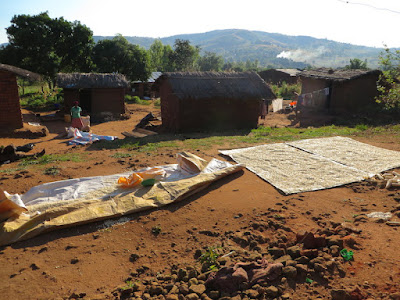In Malawi, 84% of the population lives in rural areas where the majority are engaged in subsistence farming. Even in the cities such as Blantyre where we live, you can see that many landowners and renters plant maize on small plots or steep hillsides next to their homes. Most people have ties to a village and they might go back a couple of times a year to participate in the planting and harvesting of maize on their family land.
I have been fascinated watching the entire cycle of maize production. The fields are prepared in late fall, in anticipation of the rainy season and usually they will not plant until after the first rainfall.
They have told me that they alternate the furrows each year so as not to plant in exactly the same row.
Last year the rains were late as they said they were the year before. Maize is very susceptible to drought so farmers and city people were worried. Eventually, maize was all planted by mid-December.
Within days, we saw the pretty little shoots.
These fields are actually in the city, just high up on Manja. They do not seem to be as well maintained (weeds!) as the smaller plots down by the houses.
Within two weeks, the plots are usually weeded and fertilized. However, for those families that cannot afford fertilizer, the yield is substantially less.
As we walked around town, we could see the maize growing taller almost before our eyes.
In this case, the maize has been planted along with beans.
We even had maize growing in the backyard of the Zingwangwa meetinghouse.
By about April, it is time to harvest the maize.
There are vendors all along the roads who are happy to sell you roasted corn. It looks delicious, but is not the sweet, soft corn that we are used to in the United States. It is not sweet, not soft, and it does not come with butter and salt! But it is obviously a treat for the Malawians!
Mostly, the corn is picked and the cobs of maize are left out to dry in the sun.
When the cobs have dried for several days or a week, a big family project begins. This can actually be a great social occasion because everyone is working to extract all the kernels of corn.
Suddenly, everyone wanted to participate. It's not everyday that you get to watch an azungu help with the food storage.
 |
Eventually the large pile of maize kernels is left out to dry some more.
When we went to one of the villages, there were many mats of maize out to dry.
For many families, once the maize kernels are dry, thay are packed up and stored in 50 kg bag. When it is time to use the maize, the women carry it (or a smaller portion) to the maize mill.
We ran into Sister Banda one day as she was on her way to the mill, helping a neighbor who was unable to go herself.
It seems like every neighborhood has its own maize mill.
Early in the season, when the grain is ground into a meal, it still requires another drying period before it can be stored.
So this time, the mats are filled with a maize meal.
Maize meal is finer than our corn meal, nor does it have the golden color because the African maize is white.
The maize flour is cooked into a paste to make "nsima", a thickly mashed porridge that is eaten with "ndiwo", a relish of fresh greens, onions, tomatoes. Sometimes a protein of beans or dried fish are added.
Here is a picture of nsima being prepared on a tripod of three stones.

I find nsima to be similar to polenta. It does not have much taste on its own, but when combined with other flavors, it can be quite tasty. Unlike polenta, is is eaten with one hand, usually out of one large pot. Families wash(rinse) their hands in a communal bowl before and after the meal.
This year the crop was not so much affected by the late rains. Rather, it was devastated by the flooding in January, particularly in the south. Houses were washed away, but houses can be rebuilt. It was too late to replant the maize for this years harvest. Consequently, we are getting to the difficult months when families are running out of the grain.
ADMARK (Agricultural Development and Marketing Corporation) is a government entity that buys and stores maize (and fertilizer) in order that the prices will not be jacked up in times of famine. We see ADMARK offices and silos as we drive about in the country. It is now illegal to sell Malawi maize or maize products outside of the country.
The last major famine was 2002 when the death estimates were between 300 and 3000 but we certainly hope the government is now better prepared to deal with the oncoming crisis.


























No comments:
Post a Comment